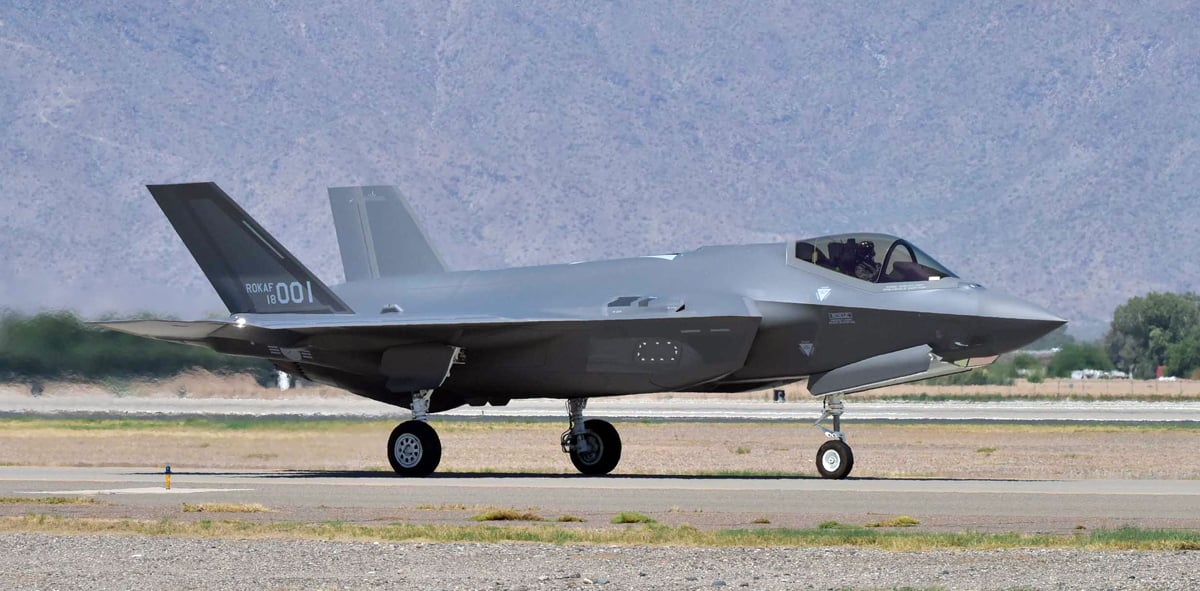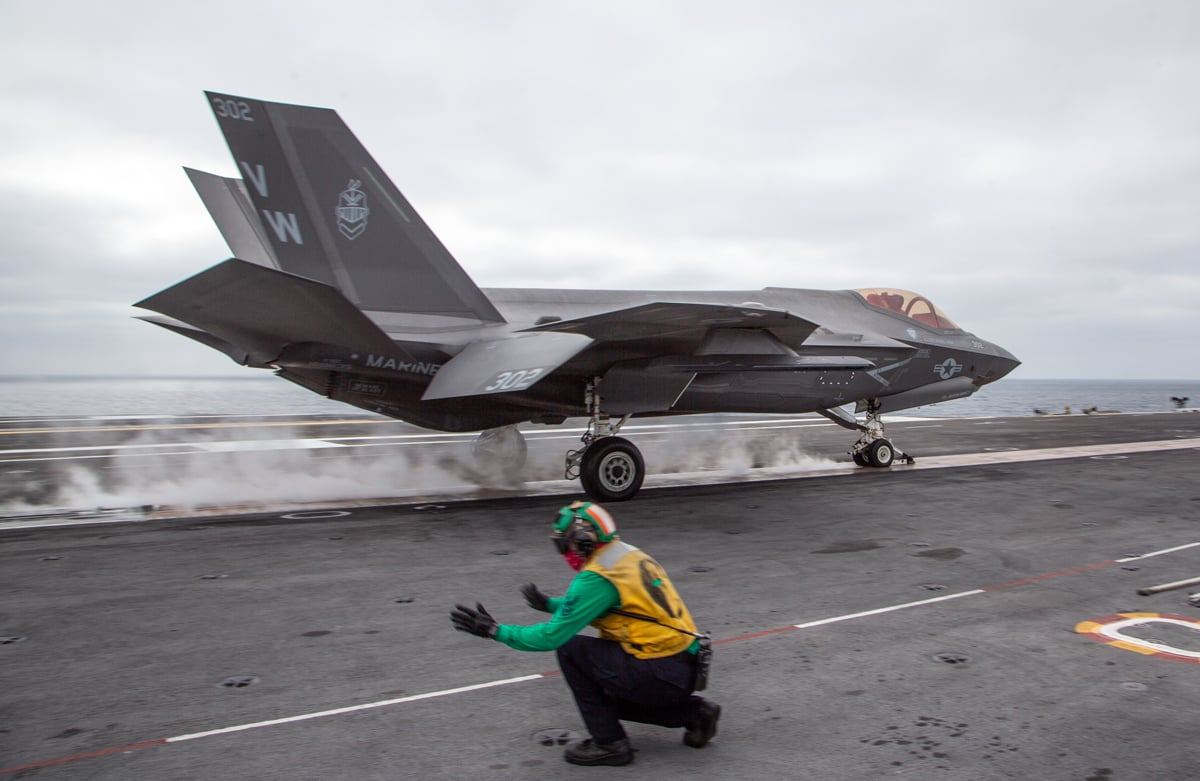Click Here to View This Page on Production Frontend
Click Here to Export Node Content
Click Here to View Printer-Friendly Version (Raw Backend)
Note: front-end display has links to styled print versions.
Content Node ID: 406615
With three powerful air arms well advanced in their plans to field the Lockheed Martin F-35 in the Asia-Pacific (APAC) region, and with the U.S. itself prioritizing the theater for its deployment, the low-observable fighter is rapidly becoming the dominant asset among West-aligned forces. Singapore is set to join the F-35 club, and possibly Thailand too, further underlining the aircraft’s importance as a counter to major threats from China, Russia, and North Korea.
Australia
Australia joined the F-35 program as a Level 3 industrial partner in 2002, placing its first order for 14 in 2009, although it deferred 12. The first of them flew in 2014, and a subsequent order raised the total to 72. It acquired the F-35A to replace the F/A-18A/B Hornet in Royal Australian Air Force (RAAF) service, a process that got underway at Williamtown in New South Wales in December 2018, where the training unit—2 Operational Conversion Unit—and two front-line squadrons (Nos. 3 and 77) began their transition to the new type. No. 3 Squadron declared initial operational capability (IOC) in December 2020.
By late 2021 the RAAF had received 44 of its 72 F-35As, and in December the final front-line unit—No. 75 Squadron at Tindal, Northern Territory—received its first aircraft. The RAAF aims to have all its aircraft operational by the end of 2023, and Australia is considering an additional purchase of F-35As. 
Republic of Korea
South Korea ordered 40 F-35As in 2014, with deliveries beginning in 2018. It has approved a follow-on batch of 20 more and possibly a similar number of F-35B short takeoff/vertical landing (STOVL) aircraft that could operate from assault carriers.
The 17th Fighter Wing of the Republic of Korea Air Force (ROKAF) at Cheongju declared IOC with 13 aircraft in December 2019. The wing has established three squadrons (151, 152, and 156) to operate the F-35A and has taken delivery of all 40 aircraft from the initial order.

Japan
Prohibited from joining the industrial program by domestic law, Japan elected for an off-the-shelf approach to acquiring the F-35, which it initially selected in December 2011 to replace the last F-4EJ Kai Phantoms of the Japan Air Self-Defense Force (JASDF). Of an initial total of 42 F-35As planned to accomplish that process, all but the first four underwent assembly at Mitsubishi’s Komaki final assembly and check-out (FACO) plant, although no parts were made in Japan.
In December 2018 the JASDF received its first aircraft at Misawa in northern Honshu, where it formed two squadrons. Both 301 and 302 Hikotai formerly operated Phantoms from Hyakuri. By the end of 2021 the JASDF had 23 aircraft operational, having lost one in an air combat training accident in April 2019.
Faced with Chinese expansion in the region, the Japanese government approved a plan in December 2018 to acquire 105 more aircraft. Of those, 63 will be F-35As and 42 are to be F-35B STOVL aircraft. Japan intends the latter to operate from dispersed bases on the country's western islands and, more important, from the navy’s two Izumo-class helicopter-carriers. Work on refitting the first of the vessels to equip it for F-35B operations began in June 2020. Assuming that Japan’s F-35 plan comes to fruition, it will make the country the largest export customer for the type.
Singapore
Japan’s plans to buy the STOVL version and the strong interest from South Korea underline the value of the F-35B in the APAC region, particularly for air arms looking to operate aircraft from small carriers/assault ships and/or from austere island and temporary highway bases. Singapore fits into that category and has begun the procurement process for a possible batch of 12 F-35Bs. The republic joined the System, Design and Development phase as a Security Co-operation Participant as long ago as 2003, but its interest in the F-35 was seen as a long-term investment. With the Lockheed Martin F-16s of the Republic of Singapore Air Force (RSAF) undergoing a major upgrade, the need to replace them would not occur until the late 2020s at the earliest.
In January 2019 the Singapore Ministry of Defense (Mindef) declared the F-35 the most suitable F-16 replacement, but at the time it did not divulge the specific variant. Rather than proceed to full acquisition, it decided to adopt a more cautious approach and order four aircraft for continued evaluation with an option to purchase a further eight at a later date. The U.S. State Department approval of Singapore’s request in January 2020 revealed that the aircraft would be the F-35B STOVL version.
Due for delivery in 2026, Singapore's F-35Bs will initially remain in the U.S. for training at Ebbing Air National Guard Base at Fort Smith, Arkansas. The RSAF’s F-16 training detachment—currently at Luke AFB, Arizona— will also relocate to Fort Smith from 2023. Plans call for replacement of the RSAF F-16s to begin in 2030.
Regional sales
Although U.S. political and security concerns curtailed the potential for further sales of F-35s into the region, another potential customer emerged in late December in the form of Thailand. The government has earmarked funds for new aircraft to modernize the Royal Thai Air Force’s fighter force, which includes aging Northrop F-5s and F-16s. The RTAF commander, Air Chief Marshal Napadej Dhupatemiya, told the Bangkok Post that the air force plans to acquire F-35s. “We don’t require a full fleet of F-35 jets,” he said. “We may use just eight to 12 and use drones to fly alongside the manned aircraft.”
Global powers
As well as those operated by regional air arms, F-35s from the U.S. forces now operate in the theater. The U.S. Air Force deployed its first F-35As outside of the “lower 48” states to the 354th Fighter Wing at Eielson AFB in Alaska. The base is seen as a strategically important location from which airpower can be rapidly deployed to Japan, South Korea, and beyond.
For the Marine Corps, the distribution of F-35Bs to front-line units has leaned heavily towards the Pacific theater, with three units (VMFA-122, 211, and 235) shore-based at MCAS Yuma in Arizona. At the Corps’ forward-deployed base at Iwakuni in Japan, the F-35B has completely displaced the AV-8B Harrier II, serving with two squadrons (VMFA-121 and 242).
Similarly, the U.S. Navy and Marine Corps have prioritized the Pacific Fleet for deployment of the F-35C carrier-capable version. The Navy has established the first main shore base for the F-35C at NAS Lemoore in California, home base to the service’s first front-line F-35C squadron (VFA-147). Also in California, the Marine base at Miramar is home to the first USMC squadron to be equipped with the type (VMFA-314).
Both the “Argonauts” of VFA-147 and the “Black Knights” of VMFA-314 are now at sea in the Pacific region, forming part of the air wings aboard USS Carl Vinson and USS Abraham Lincoln, respectively. The F-35C received unwanted attention in late January when a VFA-147 suffered a landing accident and ran overboard during operations in the South China Sea, sparking a major salvage operation.
Another F-35 operator with an expanding presence in the APAC region—the United Kingdom—recently adopted a new focus on operations in the Far East. In 2021 the carrier HMS Queen Elizabeth undertook its inaugural operational deployment and spent some time in the region. In October the vessel visited Singapore, and the F-35Bs from its joint USMC/RAF staffed air wing undertook exercises with RSAF fighters.
